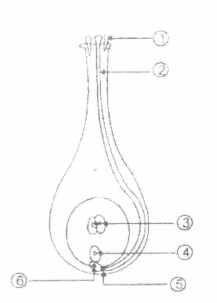

NTSE SAT Biology - Reproduction
Exam Duration: 45 Mins Total Questions : 30
Which one is not associated with gametogenesis?
- (a)
Formation of ova
- (b)
Formation of spermatid
- (c)
Release of ova
- (d)
Change of spermatids to spermatozoa
In 28 days human ovarian cycle, ovulation occurs on
- (a)
Day 1
- (b)
Day 5
- (c)
Day 14
- (d)
Day 28
A wind-pollinated flower will have
- (a)
large petals, small anther & produce scent
- (b)
small petals, nectar & produce scent
- (c)
small petals, large anthers and have a feathery stigma
- (d)
large anthers, coloured petals and produce nectar
Asexual reproduction differ from sexual reproduction in that it does not require
- (a)
One parent
- (b)
Two parents
- (c)
Spores
- (d)
Vegetative parts
Vegetative propagation does not involve
- (a)
Root parts
- (b)
Stem parts
- (c)
Leaf parts
- (d)
Flower parts
Which one of the following is not a method of asexual reproduction?
- (a)
Sporulation
- (b)
Gametogenesis
- (c)
Apomixis
- (d)
Parthenogenesis
The stamens are leaves modified for the production of
- (a)
Microspores
- (b)
Megaspores
- (c)
Ovules
- (d)
Seed
The sepals and petals are
- (a)
Reproductive part of flower
- (b)
Non-reproductive part of flower
- (c)
Part of gametophyte
- (d)
Both A & C
The stigma, the style and the ovary are contained in the
- (a)
Petals
- (b)
Seed
- (c)
Carpel
- (d)
Stamen
Which type of reproduction found in protozoa?
- (a)
Binary fission
- (b)
Budding
- (c)
Spore formation
- (d)
Fragmentation
Which organism cause Kala-azar?
- (a)
Plasmodium
- (b)
E.coli
- (c)
Salmonella
- (d)
Leishmania
Male gonads are called _____________.
- (a)
Testes
- (b)
Testes
- (c)
Ovaries
- (d)
Scrotal sacs
- (e)
Sperm duct
The fertilized egg is called ____________
- (a)
Ovum
- (b)
Blastocyst
- (c)
Diploid cell
- (d)
Zygote
The process by which the sperms are produced is known as ______________.
- (a)
Ovulation
- (b)
Spermatogenesis
- (c)
Oogenesis
- (d)
Gestation
The process by which the sperms are released is called ____________.
- (a)
Spermatogenefis
- (b)
Oogenesis
- (c)
Ovulation
- (d)
Ejaculation
The fertilization of human egg by the sperms takes place in __________.
- (a)
Ovary
- (b)
Oviduct
- (c)
Vagina
- (d)
Uterus
Successfully grafted plants bear the flowers and fruits characteristic of the ____________.
- (a)
Scion
- (b)
Stock
- (c)
Either scion or stock
- (d)
A mixture of scion and stock
Pituitary gland is located just below the:
- (a)
Brain
- (b)
Heart
- (c)
Liver
- (d)
Kidney
After ovulation Graffian follicle regresses into
- (a)
corpus atresia
- (b)
corpus callosum
- (c)
corpus luteum
- (d)
corpus albicans
Double fertilization is characteristic of
- (a)
angiosperms
- (b)
algae
- (c)
gymnosperms
- (d)
bryophytes
The polar bodies present inside the embryo sac are
- (a)
Haploid
- (b)
Diploid
- (c)
Unknown
- (d)
None of these
Parts that show chemotropic movement, fertilization and triple fusion are respectively-

- (a)
2, 3, 4
- (b)
1, 2, 3
- (c)
3, 4, 5
- (d)
2, 4, 3
Self pollination is transfer of pollen from anther to the stigma of
- (a)
Same flower
- (b)
Same or different flower of the same plant
- (c)
Same or genetically similar flower of the same or other plant
- (d)
Different flowers of the same plant
Male hormone is:
- (a)
Corpus luteum
- (b)
Testosterone
- (c)
Progesterone
- (d)
Gonadotropin
In flowers, which one of the following conditions will increase chances of self-pollination?

- (a)
Pistil is longer than stamens in a flower
- (b)
Stamens are just above the stigma of a pistil in a flower.
- (c)
In all flowers of the plant only pistil is present
- (d)
In all flowers of the plant only stamens are present.
Sperms travel during an ejeculation from the (i), where they are stored to the (ii), from where they are transported to the ejaculatory duct and then to the (iii) , which carries both reproductive and excretory fluids. A vasectomy is a surgical procedure for contraceptive purposes in which the (iv) is cut and blocked so as to prevent sperms from being present in the semen. Select the correct sequence of terms to complete the above paragraph.
- (a)
(i) (ii) (iii) (iv) Vas deferens Epididymis Urethra Vas deferens - (b)
(i) (ii) (iii) (iv) Vas deferens Epididymis Urethra Seminiferous tubules - (c)
(i) (ii) (iii) (iv) Epididymis Vas deferens Urethra Vas deferens - (d)
(i) (ii) (iii) (iv) Epididymis Vas deferens Urethra Seminiferous tubules
Leshmania reproduces asexually by
- (a)
Multiple fission
- (b)
Binary fission
- (c)
Budding
- (d)
Sporulation
Onset of menstrual cycle in females is known as
- (a)
menopause
- (b)
menostart
- (c)
menarche
- (d)
menstrarch
Development of foetus takes place in
- (a)
Oviduct
- (b)
Uterus
- (c)
Umblical cord
- (d)
Vagina
Sperms differ from ova in
- (a)
being motile
- (b)
storing food
- (c)
being bigger in size
- (d)
being produced only one in number







